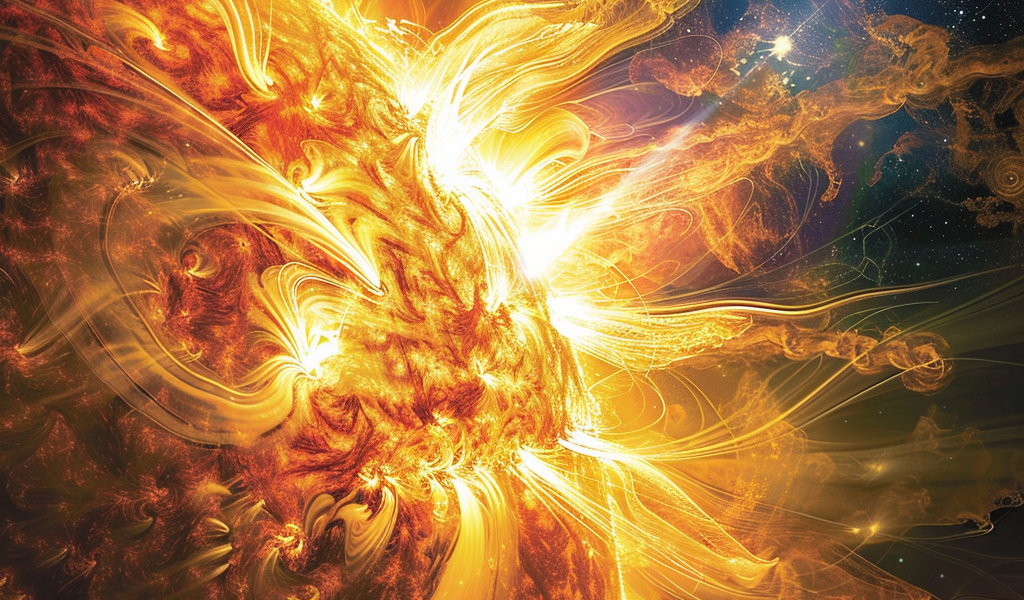Recent research has revealed that the Sun likely possesses swirling polar vortices, akin to those found on Earth and other celestial bodies. This groundbreaking study, spearheaded by the U.S. National Science Foundation’s National Center for Atmospheric Research (NSF NCAR), sheds light on the intricate dynamics of the solar magnetic field and its implications for understanding solar activity.
The findings, published in the Proceedings of the National Academy of Sciences, suggest that these vortices are not merely atmospheric phenomena but are primarily influenced by the Sun’s magnetic fields. This distinction is crucial, as it highlights the unique nature of solar dynamics compared to planetary systems.
As researchers delve deeper into the Sun’s polar regions, they anticipate that these vortices could play a significant role in the solar cycle, potentially enhancing our ability to forecast space weather events that can disrupt satellite communications and power grids on Earth.
Mausumi Dikpati, a senior scientist at NSF NCAR and the lead author of the study, emphasizes the novelty of these findings. “No one can say for certain what is happening at the solar poles,” she stated. “But this new research gives us an intriguing look at what we might expect to find when we are able, for the first time, to observe the solar poles.” This statement underlines the potential for future solar missions to uncover more about these elusive features.
The research was made possible through funding from NSF and NASA, utilizing advanced supercomputing resources from NSF NCAR’s Cheyenne and Derecho systems. These tools enabled scientists to simulate and visualize the behavior of polar vortices on the Sun, providing a clearer understanding of their formation and migration.
The concept of polar vortices is not new; they have been observed across various planets in our solar system. These swirling formations typically arise in fluids surrounding rotating bodies due to the Coriolis effect. For instance, on Earth, polar vortices can stabilize frigid air at the poles. However, when they weaken, they allow cold air to move toward the equator, leading to significant weather changes in mid-latitude regions.
NASA’s Juno mission has captured stunning images of polar vortices on Jupiter, showcasing a complex arrangement of swirls at the gas giant’s poles. Similarly, Saturn’s polar vortices, observed by the Cassini spacecraft, exhibit distinct shapes—hexagonal at the north pole and circular at the south. These variations provide valuable insights into the atmospheric dynamics of each planet.
In addition to Jupiter and Saturn, polar vortices have been documented on Mars, Venus, Uranus, Neptune, and even Saturn’s moon Titan. This widespread occurrence raises the question of whether the Sun, too, would exhibit similar features, given that it is a rotating body enveloped in a fluid-like plasma.
However, the Sun’s characteristics set it apart from the planets and moons in our solar system. Its immense magnetic field and the extreme conditions present in its atmosphere create a unique environment that influences the behavior of these vortices. Understanding these differences is essential for scientists as they seek to unravel the complexities of solar activity.
The implications of this research extend beyond mere curiosity about the Sun’s structure. Improved knowledge of solar polar vortices could lead to better predictions of space weather, which is increasingly important as our reliance on technology grows. Events such as solar flares and coronal mass ejections can have profound effects on Earth’s magnetosphere, impacting satellite operations and power infrastructure.
As the scientific community prepares for future missions aimed at studying the Sun more closely, the insights gained from this research will undoubtedly inform the planning and execution of these endeavors. By understanding the potential presence and behavior of polar vortices, scientists can enhance their observational strategies and focus on key aspects of solar dynamics.
The study serves as a reminder of the interconnectedness of our solar system and the importance of continued exploration. As technology advances and our capabilities to observe the Sun improve, the mysteries of its poles may soon be unveiled, providing a deeper understanding of our nearest star and its influence on our planet.





